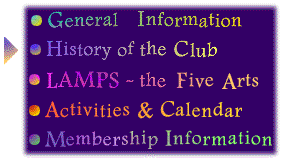

 |
 |
A Brief History of The Arts & Letters Club Toronto and the world were comparatively innocent in 1908 when about 100 men, encouraged by Augustus Bridle, a vibrant journalist covering the arts beat, met above a downtown restaurant and and made a big decision. They would institutionalize into a club what had been a pleasant but loose fellowship and thereby facilitate more regular meetings for promoting their two great interests: conversation and the arts.
"After rejecting 'PALMS' and 'LAMPS' as acronymic names", the historian Michael Bliss wrote many years later, "they decided to call themselves The Arts and Letters Club." The avowed purpose of the club was to be a rendezvous where people of diverse interests might meet for mutual fellowship and artistic creativity. It was to become a "comradely haven for kindred souls."
By the fall of 1909 permanent quarters were located at 36 1/2 King Street East, above the Brown Betty restaurant. One year and an eviction notice later, the Club moved to the second floor of 57 Adelaide Street East, the Court House of the County of York. The lease stipulated that members use the rear entrance. As this was reached from Court Street, the premises were known as the Club's Court Street Quarters. Ten years and another eviction notice later, the Club rented, and extensively renovated, the present quarters at 14 Elm Street.
It became primarily a luncheon club. Sir Edmund Walker, before being knighted for his many contributions to Toronto society, entered in his journal for Dec. 16, 1913: "Lunch, Arts & Letters Club, to meet Sir Wilfrid Laurier. First time I have met him since I opposed him in the Reciprocity Fight."
Vincent Massey, later to become Canada's first native-born Governor General, took advantage of his two years as Club President (1920-1922) by defying the frowns against publicity. In his 1963 memoir, What's Past is Prologue, he wrote:
"I spent many happy and refreshing hours at the Arts and Letters Club in Toronto. It had, and still has vitality and personality... The presiding genius of the Club for many years was Augustus Bridle, who fully embodied its spirit. One of his greatest contributions was to lose its constitution so that we were not duly concerned with machinery. The constitution did survive in musical form, having been set to plainsong by Healey Willan."
Massey was at the helm in 1920 when the Club finally obtained permanent and conventional quarters by renting St. George's Hall on Toronto's Elm Street. Unbelievably, the Club was still renting the premises from the St. George's Society 66 years later when, in 1986, the Society finally agreed to sell.
With something over 500 members, the Club's restored constitution requires that 60 percent of members be involved in the arts. Over the years these have included many prominent practitioners in the fields represented by the acronym LAMPS: Literature, Architecture, Music, Painting, sculpture and photography, & Stage. Perhaps none has brought more prominence to the Club than the Group of Seven, those pioneering landscape painters who convinced art lovers that Canadian art did not have to copy the dark traditions of Europe but could celebrate the bright and vigorous vistas of Algonquin Park and the Arctic and the western mountains with canvases to match. All seven were members of the Club and, according to the late A.J. Casson, who liked to call himself "number eight of the Group of Seven", they all would meet "just about every day, for company and a good meal".
Of all the members of the Group of Seven, J.E.H. MacDonald contributed most to The Arts and Letters Club. Not only did he provide his design skills for Club needs, but he also served on the executive for nine years, including four years as vice- president and two as president. In 1909 he designed the Club crest. As explained by one-time president C.W. Jeffreys, "The Viking ship with sails full spread before the rising sun" was to remind members "of the open sea and the great adventure."
Today the Club is full of activity but it has not forgotten the hunger people have for companionship and quiet discussion. It looks forward to its centenary as it gathers together the long list of names and accomplishments that have been proof of the vision of the few, early in the century, that material and spiritual success can flourish hand in hand.
General Info | History | LAMPS | Activities & Calendar | Membership | Contact | Home